2018年08月14日 16:58
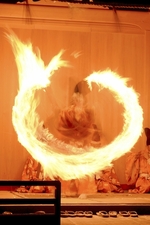 Akiha belief had been spread all over Japan like crazy in middle of the Edo period. Fire-proof belief groups had kept on increasing 30 thousand and Akiha believers had reached millions.
Akiha belief had been spread all over Japan like crazy in middle of the Edo period. Fire-proof belief groups had kept on increasing 30 thousand and Akiha believers had reached millions.
There remained many records of traveling to Akihasan and we can deduce this religious boom from them. According to 69% records, travelers walking on Tokaido to go to worship the Akiha shrine separated at Kakegawa stage for Akihasan. And after a worship, at Goyu stage in Aichi they joined Tokaido again. They continued to travel for the Grand Shrine of Ise in Mie and on their way home they passed on Nakasendo for the Zenkoji temple in Nagano. About 80% of them, including the case of on theiir way home, stopped at Akihasan on their sightseeing travel.
It is a surprising fact that the worship at Akiha shrine was a typical course of sightseeing in those days.
Akiha belief became an explosive boom.≫
カテゴリー
 Akiha belief had been spread all over Japan like crazy in middle of the Edo period. Fire-proof belief groups had kept on increasing 30 thousand and Akiha believers had reached millions.
Akiha belief had been spread all over Japan like crazy in middle of the Edo period. Fire-proof belief groups had kept on increasing 30 thousand and Akiha believers had reached millions. There remained many records of traveling to Akihasan and we can deduce this religious boom from them. According to 69% records, travelers walking on Tokaido to go to worship the Akiha shrine separated at Kakegawa stage for Akihasan. And after a worship, at Goyu stage in Aichi they joined Tokaido again. They continued to travel for the Grand Shrine of Ise in Mie and on their way home they passed on Nakasendo for the Zenkoji temple in Nagano. About 80% of them, including the case of on theiir way home, stopped at Akihasan on their sightseeing travel.
It is a surprising fact that the worship at Akiha shrine was a typical course of sightseeing in those days.
2018年08月14日 16:57
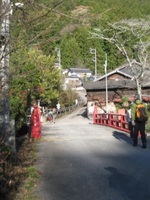 The name of this bridge is “Kuribashi”. “Kuri” means “9 villages”. People in old times named the bridge “Kuribashi”, according to the distance from both Kakegawa and Hamamatsu.
The name of this bridge is “Kuribashi”. “Kuri” means “9 villages”. People in old times named the bridge “Kuribashi”, according to the distance from both Kakegawa and Hamamatsu.
“The village” is unit of length in Japanese traditional measures. They are equivalent to 3.9km in approximately.
But it is difficult to measure it directly because “1 village” is long distance. Therefore they came to call the distance that walked in that time from rough time to take to walk from the starting point to the next.
“Kuribashi” is the starting point of the front approach to Akihasan.
“Kuribashi” means “9 villages bridge”.≫
カテゴリー
 The name of this bridge is “Kuribashi”. “Kuri” means “9 villages”. People in old times named the bridge “Kuribashi”, according to the distance from both Kakegawa and Hamamatsu.
The name of this bridge is “Kuribashi”. “Kuri” means “9 villages”. People in old times named the bridge “Kuribashi”, according to the distance from both Kakegawa and Hamamatsu. “The village” is unit of length in Japanese traditional measures. They are equivalent to 3.9km in approximately.
But it is difficult to measure it directly because “1 village” is long distance. Therefore they came to call the distance that walked in that time from rough time to take to walk from the starting point to the next.
“Kuribashi” is the starting point of the front approach to Akihasan.
2018年08月14日 16:55
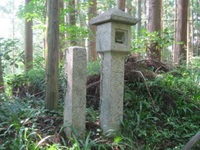 Cho-stones were stood on the approach to a shrine or a temple for a guidepost every 1 town (approximatel 109 meters). These were left in the front approach to Akihasan.
Cho-stones were stood on the approach to a shrine or a temple for a guidepost every 1 town (approximatel 109 meters). These were left in the front approach to Akihasan.
“Joyato” means a streetlight working through every night. Many of them are made of stone and classified in a kind of stone lanterns. They were built in the old times, for example the Edo Era. When they were built, they lightened and guided the way to Akihasan. The old Japanese people lighted rapeseed oil or candle in them every night for the travelers to visit Akihasan. These were probably the route signs to this religious mountain.
But the other of them were built by more religious motives. In Japan, most of our houses are made of wood, and easy to be burned. So old Japanese people were entirely dependent on a fire-proof belief. Akiha belief had spread all over Japan in no time. Then many branches of the Akiha shrine have been built all over our country and a construction of “jyoyato” in the neighborhood became to be popular. Someone represented his neighbors to visit the Akiha shrine, took back a wooden or paper charm for their safe against a fire and put it in their “jyoyato”.
Now we can find many stone lanterns on the road side, especially in Ensyu district, Shizuoka prefecture.
Cho-stone & Joyato≫
カテゴリー
 Cho-stones were stood on the approach to a shrine or a temple for a guidepost every 1 town (approximatel 109 meters). These were left in the front approach to Akihasan.
Cho-stones were stood on the approach to a shrine or a temple for a guidepost every 1 town (approximatel 109 meters). These were left in the front approach to Akihasan.“Joyato” means a streetlight working through every night. Many of them are made of stone and classified in a kind of stone lanterns. They were built in the old times, for example the Edo Era. When they were built, they lightened and guided the way to Akihasan. The old Japanese people lighted rapeseed oil or candle in them every night for the travelers to visit Akihasan. These were probably the route signs to this religious mountain.
But the other of them were built by more religious motives. In Japan, most of our houses are made of wood, and easy to be burned. So old Japanese people were entirely dependent on a fire-proof belief. Akiha belief had spread all over Japan in no time. Then many branches of the Akiha shrine have been built all over our country and a construction of “jyoyato” in the neighborhood became to be popular. Someone represented his neighbors to visit the Akiha shrine, took back a wooden or paper charm for their safe against a fire and put it in their “jyoyato”.
Now we can find many stone lanterns on the road side, especially in Ensyu district, Shizuoka prefecture.
2018年08月14日 16:53
 “Torii” means a gateway to a Shinto shrine. There were 3 metal Torii on Omote-sando in the old time. But the government demanded to let these Torii supplied for metal while the World War II was carried out.
“Torii” means a gateway to a Shinto shrine. There were 3 metal Torii on Omote-sando in the old time. But the government demanded to let these Torii supplied for metal while the World War II was carried out.
Now, a big Joyato stands where the first Torii had stood on. This Joyato was contributed by the people lived in Tokyo, in 1795, the Edo Era.
There are 3 sites of Torii remained.≫
カテゴリー
 “Torii” means a gateway to a Shinto shrine. There were 3 metal Torii on Omote-sando in the old time. But the government demanded to let these Torii supplied for metal while the World War II was carried out.
“Torii” means a gateway to a Shinto shrine. There were 3 metal Torii on Omote-sando in the old time. But the government demanded to let these Torii supplied for metal while the World War II was carried out.Now, a big Joyato stands where the first Torii had stood on. This Joyato was contributed by the people lived in Tokyo, in 1795, the Edo Era.
2018年08月14日 16:51
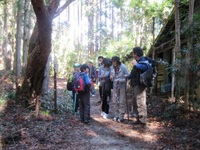 There remained the ruins of old tea house. One is “Fujimi-chaya”, the tea house suitable for looking at Mt. Fuji. Many visitors in the old time had looked at Mt. Fuji in the east. But many trees obstruct the view today.
There remained the ruins of old tea house. One is “Fujimi-chaya”, the tea house suitable for looking at Mt. Fuji. Many visitors in the old time had looked at Mt. Fuji in the east. But many trees obstruct the view today.
And the ruin of “Sakura-chaya”, the tea house of cherry blossom, is still made up with the blooming of old cherry trees in the spring.
The ruins of the old tea houses≫
カテゴリー
 There remained the ruins of old tea house. One is “Fujimi-chaya”, the tea house suitable for looking at Mt. Fuji. Many visitors in the old time had looked at Mt. Fuji in the east. But many trees obstruct the view today.
There remained the ruins of old tea house. One is “Fujimi-chaya”, the tea house suitable for looking at Mt. Fuji. Many visitors in the old time had looked at Mt. Fuji in the east. But many trees obstruct the view today.And the ruin of “Sakura-chaya”, the tea house of cherry blossom, is still made up with the blooming of old cherry trees in the spring.
2018年08月14日 16:50
 Koyasu-jizo is “Ksitigarbha of easy childbirthing”. They place a ladle drilled several holes at Koyasu-jizo and prays as an easy delivery like a water leak.
Koyasu-jizo is “Ksitigarbha of easy childbirthing”. They place a ladle drilled several holes at Koyasu-jizo and prays as an easy delivery like a water leak.
Koyasu-jizo≫
カテゴリー
 Koyasu-jizo is “Ksitigarbha of easy childbirthing”. They place a ladle drilled several holes at Koyasu-jizo and prays as an easy delivery like a water leak.
Koyasu-jizo is “Ksitigarbha of easy childbirthing”. They place a ladle drilled several holes at Koyasu-jizo and prays as an easy delivery like a water leak.
2018年08月14日 16:48
 There is a fine view near the steel tower high-voltage line. We can look at Mt. Fuji in the east easily. And we can look at the central city area of Hamamatsu, Pacific Ocean in the distance too.
There is a fine view near the steel tower high-voltage line. We can look at Mt. Fuji in the east easily. And we can look at the central city area of Hamamatsu, Pacific Ocean in the distance too.
There is a table and benches for taking a rest.
Look around it far and wide.≫
カテゴリー
 There is a fine view near the steel tower high-voltage line. We can look at Mt. Fuji in the east easily. And we can look at the central city area of Hamamatsu, Pacific Ocean in the distance too.
There is a fine view near the steel tower high-voltage line. We can look at Mt. Fuji in the east easily. And we can look at the central city area of Hamamatsu, Pacific Ocean in the distance too.There is a table and benches for taking a rest.
2018年08月14日 16:47
 Shingen was a famous military commander in the Warring State period. According to a local legend, Shingen put his leg on this stone and bowed to a lord. Then he hit it against Ieyasu, the first Tokugawa shogun, in the mountain opposite.
Shingen was a famous military commander in the Warring State period. According to a local legend, Shingen put his leg on this stone and bowed to a lord. Then he hit it against Ieyasu, the first Tokugawa shogun, in the mountain opposite.
Shingen-iwa≫
カテゴリー
 Shingen was a famous military commander in the Warring State period. According to a local legend, Shingen put his leg on this stone and bowed to a lord. Then he hit it against Ieyasu, the first Tokugawa shogun, in the mountain opposite.
Shingen was a famous military commander in the Warring State period. According to a local legend, Shingen put his leg on this stone and bowed to a lord. Then he hit it against Ieyasu, the first Tokugawa shogun, in the mountain opposite.
2018年08月14日 16:45
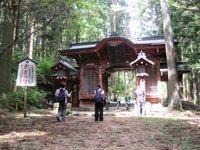 In the legend, a guardian god of the Syuyoji temple had been born as an incarnation of the Kannon in Shinano country and was called Sanjakubo. He became a priest when he was 6 or 7 years old and practiced asceticism in some temples. After a long time, he recieved miracle magic beyond human power and transformed him into a long-nosed goblin. He could fly in the sky like a crow. He flied freely to Mt. Akiha on a white fox's back.
In the legend, a guardian god of the Syuyoji temple had been born as an incarnation of the Kannon in Shinano country and was called Sanjakubo. He became a priest when he was 6 or 7 years old and practiced asceticism in some temples. After a long time, he recieved miracle magic beyond human power and transformed him into a long-nosed goblin. He could fly in the sky like a crow. He flied freely to Mt. Akiha on a white fox's back.
The red gate of Syuyoji temple with the statue of a Deva king standing on either side is called Nio-mon.
It is decorated with sculptures of 4 holy animals, a dragon, a phoenix, a giraffe and a lion around the ceiling.
Nio-mon in Sanjakubo, a Deva gate≫
カテゴリー
 In the legend, a guardian god of the Syuyoji temple had been born as an incarnation of the Kannon in Shinano country and was called Sanjakubo. He became a priest when he was 6 or 7 years old and practiced asceticism in some temples. After a long time, he recieved miracle magic beyond human power and transformed him into a long-nosed goblin. He could fly in the sky like a crow. He flied freely to Mt. Akiha on a white fox's back.
In the legend, a guardian god of the Syuyoji temple had been born as an incarnation of the Kannon in Shinano country and was called Sanjakubo. He became a priest when he was 6 or 7 years old and practiced asceticism in some temples. After a long time, he recieved miracle magic beyond human power and transformed him into a long-nosed goblin. He could fly in the sky like a crow. He flied freely to Mt. Akiha on a white fox's back.The red gate of Syuyoji temple with the statue of a Deva king standing on either side is called Nio-mon.
It is decorated with sculptures of 4 holy animals, a dragon, a phoenix, a giraffe and a lion around the ceiling.
2018年08月14日 16:43
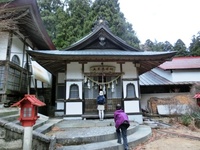 Daikokuten is worshiped next to the main hall of Syuyoji temple. Daikokuten, known as “Daikokusama” is the god presiding over food and wealth, and was counted one of the seven Shichifukujin, Seven Gods of Good Fortune.
Daikokuten is worshiped next to the main hall of Syuyoji temple. Daikokuten, known as “Daikokusama” is the god presiding over food and wealth, and was counted one of the seven Shichifukujin, Seven Gods of Good Fortune.
Daikokuten≫
カテゴリー
 Daikokuten is worshiped next to the main hall of Syuyoji temple. Daikokuten, known as “Daikokusama” is the god presiding over food and wealth, and was counted one of the seven Shichifukujin, Seven Gods of Good Fortune.
Daikokuten is worshiped next to the main hall of Syuyoji temple. Daikokuten, known as “Daikokusama” is the god presiding over food and wealth, and was counted one of the seven Shichifukujin, Seven Gods of Good Fortune.
2018年08月14日 16:40
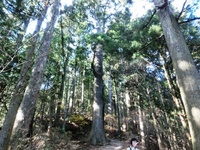 Akihasan is the mountain where many cedars grow. And some remaining cedars in repeated wildfires are more than 500 years old.
Akihasan is the mountain where many cedars grow. And some remaining cedars in repeated wildfires are more than 500 years old.
Akiha cedars≫
カテゴリー
 Akihasan is the mountain where many cedars grow. And some remaining cedars in repeated wildfires are more than 500 years old.
Akihasan is the mountain where many cedars grow. And some remaining cedars in repeated wildfires are more than 500 years old.
2018年08月14日 16:38
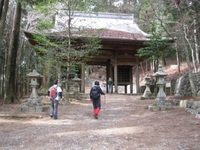 Zuishin-mon is the oldest wooden structure in Akihasan. Akihasan was dameged in forest fires many times. But only this gate was escaped the fire.
Zuishin-mon is the oldest wooden structure in Akihasan. Akihasan was dameged in forest fires many times. But only this gate was escaped the fire.
It is decorated with sculptures of Tennyo, a heavenly maiden carved by famous engraver, Washiro Tachikawa in Edo Era.
And it is guarded with two guardian gods sitting on either side.
Zuishin-mon, the oldest structure in Akihasan≫
カテゴリー
 Zuishin-mon is the oldest wooden structure in Akihasan. Akihasan was dameged in forest fires many times. But only this gate was escaped the fire.
Zuishin-mon is the oldest wooden structure in Akihasan. Akihasan was dameged in forest fires many times. But only this gate was escaped the fire.It is decorated with sculptures of Tennyo, a heavenly maiden carved by famous engraver, Washiro Tachikawa in Edo Era.
And it is guarded with two guardian gods sitting on either side.
2018年08月14日 16:36
 Akiha belief is a combination of Buddhism and the old Japanese traditional belief.
Akiha belief is a combination of Buddhism and the old Japanese traditional belief.
Akihasan was originally worshipped as a god of war in the Warring State period. Many of daimyo and samurai contributed their swords to Akihasan, the Temple and the Shrine.
But people worshiped there as the god of fire-proof. I don't know the true reason. But I can imagine that they became more interested in fire-proof than bulletproof in the long time of peace, the Edo Era.
In the Meiji period, the government had separated the Akihasan from the Buddhism and Akihasan was reborn as Akiha Shrine.
But, in spite of the fire-proof prayer, unfortunately the Shrine was all burnt out by big fires without the old gate.
After the last big fire, Akiha shrine was rebuilt on the top of Akiha mountain. And they had builted the golden gate in front of the main shrine.
Akiha Shrine and golden gate≫
カテゴリー
 Akiha belief is a combination of Buddhism and the old Japanese traditional belief.
Akiha belief is a combination of Buddhism and the old Japanese traditional belief.Akihasan was originally worshipped as a god of war in the Warring State period. Many of daimyo and samurai contributed their swords to Akihasan, the Temple and the Shrine.
But people worshiped there as the god of fire-proof. I don't know the true reason. But I can imagine that they became more interested in fire-proof than bulletproof in the long time of peace, the Edo Era.
In the Meiji period, the government had separated the Akihasan from the Buddhism and Akihasan was reborn as Akiha Shrine.
But, in spite of the fire-proof prayer, unfortunately the Shrine was all burnt out by big fires without the old gate.
After the last big fire, Akiha shrine was rebuilt on the top of Akiha mountain. And they had builted the golden gate in front of the main shrine.
2018年08月14日 16:33
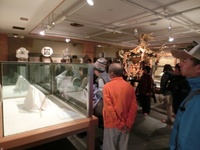 There is a lot of swords dedicated by old warriors on display. Some national treasures are in them. And famous Hiroshige Ukiyo-e prints are also exhibited.
There is a lot of swords dedicated by old warriors on display. Some national treasures are in them. And famous Hiroshige Ukiyo-e prints are also exhibited.
Treasure Museum≫
カテゴリー
 There is a lot of swords dedicated by old warriors on display. Some national treasures are in them. And famous Hiroshige Ukiyo-e prints are also exhibited.
There is a lot of swords dedicated by old warriors on display. Some national treasures are in them. And famous Hiroshige Ukiyo-e prints are also exhibited.
2018年08月14日 16:31
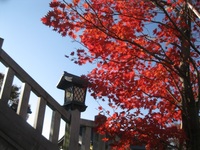 “Akiha” means autumn leaves. Many maple trees are dressed by scarlet-tinged leaves in every autumn.
“Akiha” means autumn leaves. Many maple trees are dressed by scarlet-tinged leaves in every autumn.
We, especially Japanese people, love autumn leaves. Let’s walk to enjoy them in Akihasan.
“Akiha” means autumn leaves.≫
カテゴリー
 “Akiha” means autumn leaves. Many maple trees are dressed by scarlet-tinged leaves in every autumn.
“Akiha” means autumn leaves. Many maple trees are dressed by scarlet-tinged leaves in every autumn.We, especially Japanese people, love autumn leaves. Let’s walk to enjoy them in Akihasan.
